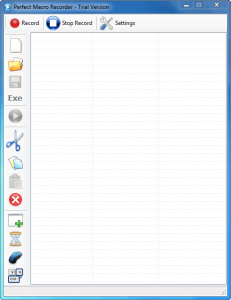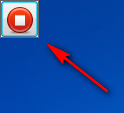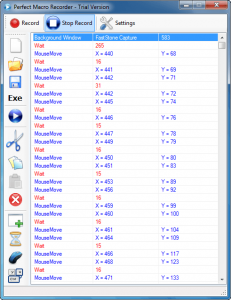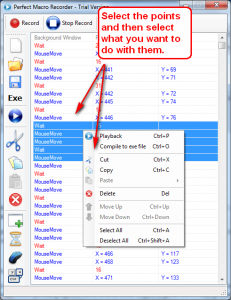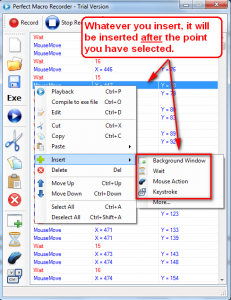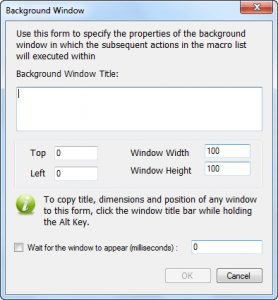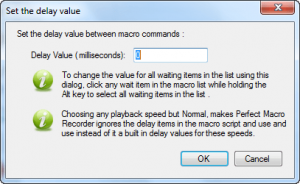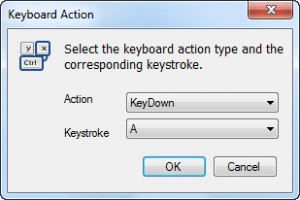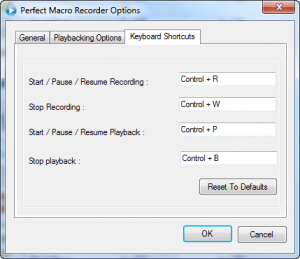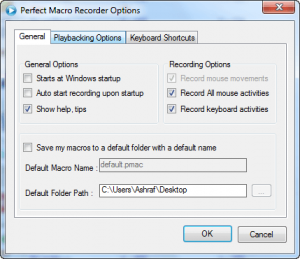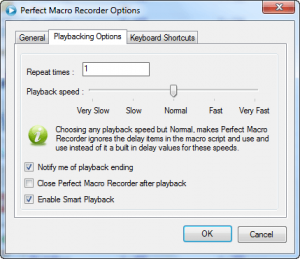{rw_text}Software reviewed in this article:
Perfect Macro Recorder by Perfect Tools Software
Version reviewed:
v2.0.0.0
System Requirements:
Windows NT4/2000/XP/2003/Vista
Needs .NET Framework 3.50
Price:
$39.90 (USD) but you can get it for free for a limited time at Giveawayoftheday.com!
Software description as per the developer:
Automate your tasks by recording keystrokes, mouse actions, so you can replay later. You can also convert the macro to an executable file [*.exe] that can be run stand alone without Perfect Macro Recorder.
————————-{/rw_text} –>
{rw_good}
- Records all mouse (strokes, clicks, scrolls, etc.) and keyboard activity.
- Supports the use of hotkeys for recording and playback.
- Allows user to manually edit the macro after it has been recorded.
- Allows user to export macro to standalone EXE file.
- Allows user to playback macro slower or faster than normal pace and to repeat playback X amount of times.
{/rw_good} –>
{rw_bad}
- Has a few bugs.
- Mouse activity is based off coordinates instead of program/window recognition.
- Impractical means of editing macros.
- No help file.
{/rw_bad} –>
{rw_score}
{for=”Ease of Use” value=”8″}Aside from the impractical means of editing the macros, very easy to use.
{/for}
{for=”Performance” value=”6″}For the most part performs well. However, has a few bugs that need to be ironed out.
{/for}
{for=”Usefulness” value=”6″}In general, macro programs are a hit or a miss; either you can use it or you can’t.
{/for}
{for=”Price” value=”4″}$39.90 is much too overpriced for what is not that advanced of a macro recorder. A better price for this is $10-15.
{/for}
{for=”Arbitrary Equalizer” value=”6″}This category reflects an arbitrary number that does not specifically stand for anything. Rather this number is used to reflect dotTech’s overall rating/verdict of the program in which all the features and alternatives have been considered.
{/for}
{/rw_score} –>
{rw_verdict}[tdown]
{/rw_verdict} –>
Perfect Macro Recorder is a macro recording program. The four main things it allows users to do are:
- Record all mouse and keyboard activity
- Playback recorded macros at normal speed or faster/slower than normal
- Edit macros after they have been recorded
- Export macros as standalone EXE files
This is what the main program window for PMR (Perfect Macro recorder) looks like:
To start recording a macro, simply hit the Record button. After you hit the Record button, the main program window will automatically be minimized and all of your mouse and keyboard actions will be recorded. When you are done recording a macro, simply click on the red circle located at the top left of your computer screen…
…and the macro will stop recoding. After the macro has stopped recording, the main program window for PMR will automatically maximize, giving you the option to edit your macro, play it back, and/or save it:
Editing the macro consists of manually deleting/cutting/copying/pasting macro points, adding “background windows”, delays, mouse actions, and/or keyboard actions.
When deleting/cutting/copying macro points, you simply need to select the macro points you want to cut/copy, right click, and select delete, cut, or copy (whichever one you want to do):
If you select an individual point, you can also move it up/down at your discretion and edit what it does (for example, change the wait time from “16 to 100”).
If you are looking to add a custom “background window”, delay, or mouse/keyboard action, simply select the macro point that you want to add the action after, right click, go to “Insert”, and select what you want to add:
Background Window
Delay/Wait
Mouse Action
Keyboard Action/Keystroke
After your macro is as you like it, you can preview it by hitting the play button…
…or save it:
The floppy disk icon will save the macro normally and the “Exe” will save it as a standalone EXE file. The difference between saving the macro normally and saving it as a standalone EXE is saving it normally requires PMR to be installed to be played back but saving it as an EXE allows anyone to play it back, regardless of if PMR is installed or not.
Since saving macro to EXE does not require PMR to be installed, you have to set a few settings before you save it to EXE:
In addition to all that has been mentioned already, other noteworthy aspects of PMR are:
- The ability to use hotkeys to record/playback:
- The settings:
Now on paper, Perfect Macro Recorder looks like quite a lucrative program because of the features it offers (especially the “background window” feature). However, in practice, PMR still needs a bit of work:
- First and foremost, there is no help file, nor is there any sort of help offered on the developer’s website. True enough that most of PMR is fairly self explanatory, but would be greatly appreciated.
- Secondly, there are a couple of bugs with PMR that I experience:
- The “background window” feature does absolutely nothing. From the description of what it is supposed to, I understand that you can set it so the macro you recorded will only occur if a specific window is open/active. However, I tested this feature out and the macro played every time regardless of if the designated window was on/active or not.
- When playing back a macro that involved mouse scrolling, the program – literally – made my computer implode (to an extent). Instead of properly repeating the mouse scrolling actions, PMR messed up my mouse and keyboard so that the mouse scroll would no longer scroll but zoom in/out and my keyboard keys no longer did their proper tasks (i.e. pressing “d” did not type d but open a window, for example). Thankfully, a computer reset solved this problem but I was able to replicate it over and over so it is definitely a bug and not a one time thing.
- Thirdly, related to the idea that the “background window” feature does not work, all mouse activity is based off coordinates instead of program/window recognition. (All mouse movements/strokes are recorded at a superficial level and not an in depth level.) What I mean is the programs records where your mouse moves and where you click relative to the screen. It does not record what you move to or what you click on; the macros that are recorded are not program or window specific. So, for example, you create a macro while you are on your desktop. This macro goes and clicks on your Firefox icon which is located in the very top right of the desktop. As long as your Firefox icon is there, whenever you run this macro while at your desktop the macro will successfully launch Firefox. Now lets say you have a folder open and maximized so you are not at your desktop. If you run the macro then, the macro will still make your mouse go to the top right of your screen and click. However Firefox will not be launched because you are not at your desktop; rather whatever is located in the top right of the screen at the time, probably the “X” button, will be clicked upon. Do you get what I mean? What I am trying to say is that the program does not record what happens but rather how it happens.
- Fourthly, the method to edit macros is very impractical. Yes it is nice to be able to add custom delays/mouse and keyboard actions, but in order to effectively use these editing features, you have to know where to place them. Knowing where to place them is a near impossible task because the macro is just a list of actions – you can hardly know which action is what. So you can’t know, for example, what action is the one where you open Firefox so you can’t insert a delay after it. To improve this, I would like to see some sort of “editing mode” feature. In this “editing mode” the macro would be played back (at a slow pace if desired by the user) and whenever the user paused the playback, that specific point in the macro would be highlighted in the action list. This way a user can easily identify where to insert, for example, an extra delay.
- Lastly, if you record a macro with a maximized window, during playback, the window will be unmaximized, but stretch all the way so it covers your full screen. This is very annoying.
This review was conducted on a laptop running Windows 7 Professional 32-bit. The specs of the laptop are as follows: 3GB of RAM, a Radeon HD 2600 512MB graphics card, and an Intel T8300 2.4GHz Core 2 Duo processor.
{rw_freea}
Do It Again is an extremely easy-to-use macro recorder which records all keyboard and mouse clicks.
Comfort Keys Lite is an awesome hotkey program. One of the many features it has is the ability to create macros; however the macros only record keyboard keypresses and not mouse movements/clicks.
A simple mouse movement/clicks recorder.
AutoHotkey is a free, open-source utility for Windows. With it, you can:
- Automate almost anything by sending keystrokes and mouse clicks. You can write a mouse or keyboard macro by hand or use the macro recorder.
- Create hotkeys for keyboard, joystick, and mouse. Virtually any key, button, or combination can become a hotkey.
- Expand abbreviations as you type them. For example, typing “btw” can automatically produce “by the way”.
- Create custom data-entry forms, user interfaces, and menu bars. See GUI for details.
- Remap keys and buttons on your keyboard, joystick, and mouse.
- Respond to signals from hand-held remote controls via the WinLIRC client script.
- Run existing AutoIt v2 scripts and enhance them with new capabilities.
- Convert any script into an EXE file that can be run on computers that don’t have AutoHotkey installed.
If you are interested, check out the quick-start tutorial. Here is the AutoHotKey wiki.
-AutoHotKey Developer
—-
All I have to say about AutoHotKey is that it may be a better macro program overall then Easy Macro Recorder but it is much harder/more complicated to create macros with AHK then with EMR.
AutoIt is a very similar program to AutoHotKey. Personally I found AutoHotKey a bit easier to understand and use, but imo it comes down to personal preference. Again, while AutoIt may be a superior macro program then Easy Macro Recorder, Easy Macro Recorder is much more simple and easy to use.
—-
AutoIt v3 is a freeware BASIC-like scripting language designed for automating the Windows GUI and general scripting. It uses a combination of simulated keystrokes, mouse movement and window/control manipulation in order to automate tasks in a way not possible or reliable with other languages (e.g. VBScript and SendKeys). AutoIt is also very small, self-contained and will run on all versions of Windows out-of-the-box with no annoying “runtimes” required!
Features:
- Easy to learn BASIC-like syntax
- Simulate keystrokes and mouse movements
- Manipulate windows and processes
- Interact with all standard windows controls
- Scripts can be compiled into standalone executables
- Create Graphical User Interfaces (GUIs)
- COM support
- Regular expressions
- Directly call external DLL and Windows API functions
- Scriptable RunAs functions
- Detailed helpfile and large community-based support forums
- Compatible with Windows 95 / 98 / ME / NT4 / 2000 / XP / 2003 / Vista / 2008
- Unicode and x64 support
- Digitally signed for peace of mind
- Works with Windows Vista’s User Account Control (UAC)
-AutoIt Developer
Seems like a dead simple mouse/keyboard macro recorder. However it doesn’t install properly on my computer so I can’t say much about it.
Seems like a really nice macro recording programs it doesn’t work on my computer so I can’t say much about it.
{/rw_freea} –>
{rw_verdict2}At the surface – because of the features it offers – Perfect Macro Recorder looked more promising than other macro recorders I have run across. However after testing it for myself, I do feel Perfect Macro Recorder has too many problems to be out in the public domain just yet; thumbs down. For advanced users, I recommend looking into AutoHotKey or AutoIt for macro needs. For not-so-advanced users, I have been using Do It Again for a while, and I recommend it.
{/rw_verdict2} –>
Comfort Keys Lite is an awesome hotkey program. One of the many features it has is the ability to create macros; however the macros only record keyboard keypresses and not mouse movements/clicks.
Ghost Mouse
A simple mouse movement/clicks recorder.
AutoHotKey
AutoHotkey is a free, open-source utility for Windows. With it, you can:
* Automate almost anything by sending keystrokes and mouse clicks. You can write a mouse or keyboard macro by hand or use the macro recorder.
* Create hotkeys for keyboard, joystick, and mouse. Virtually any key, button, or combination can become a hotkey.
* Expand abbreviations as you type them. For example, typing “btw” can automatically produce “by the way”.
* Create custom data-entry forms, user interfaces, and menu bars. See GUI for details.
* Remap keys and buttons on your keyboard, joystick, and mouse.
* Respond to signals from hand-held remote controls via the WinLIRC client script.
* Run existing AutoIt v2 scripts and enhance them with new capabilities.
* Convert any script into an EXE file that can be run on computers that don’t have AutoHotkey installed.
If you are interested, check out the quick-start tutorial. Here is the AutoHotKey wiki.
-AutoHotKey Developer
—-
All I have to say about AutoHotKey is that it may be a better macro program overall then Easy Macro Recorder but it is much harder/more complicated to create macros with AHK then with EMR.
AutoIt
AutoIt is a very similar program to AutoHotKey. Personally I found AutoHotKey a bit easier to understand and use, but imo it comes down to personal preference. Again, while AutoIt may be a superior macro program then Easy Macro Recorder, Easy Macro Recorder is much more simple and easy to use.
—-
AutoIt v3 is a freeware BASIC-like scripting language designed for automating the Windows GUI and general scripting. It uses a combination of simulated keystrokes, mouse movement and window/control manipulation in order to automate tasks in a way not possible or reliable with other languages (e.g. VBScript and SendKeys). AutoIt is also very small, self-contained and will run on all versions of Windows out-of-the-box with no annoying “runtimes” required!
Features:
* Easy to learn BASIC-like syntax
* Simulate keystrokes and mouse movements
* Manipulate windows and processes
* Interact with all standard windows controls
* Scripts can be compiled into standalone executables
* Create Graphical User Interfaces (GUIs)
* COM support
* Regular expressions
* Directly call external DLL and Windows API functions
* Scriptable RunAs functions
* Detailed helpfile and large community-based support forums
* Compatible with Windows 95 / 98 / ME / NT4 / 2000 / XP / 2003 / Vista / 2008
* Unicode and x64 support
* Digitally signed for peace of mind
* Works with Windows Vista’s User Account Control (UAC)
-AutoIt Developer
Macro Recorder
Seems like a dead simple mouse/keyboard macro recorder. However it doesn’t install properly on my computer so I can’t say much about it.
MacroMaker
Seems like a really nice macro recording programs it doesn’t work on my computer so I can’t say much about it.

 Email article
Email article
